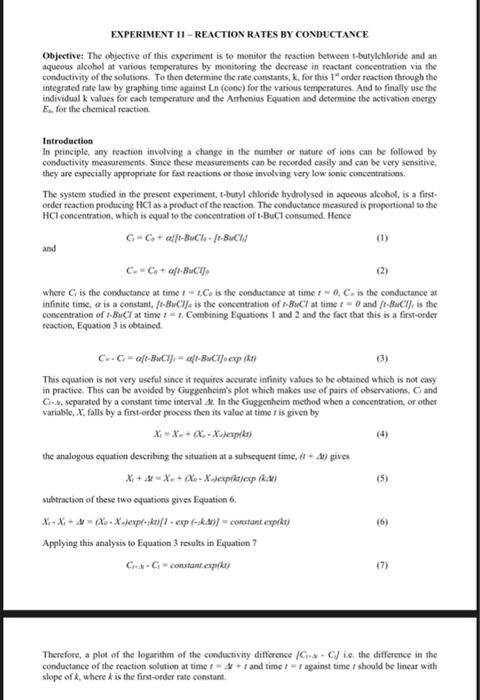Answered step by step
Verified Expert Solution
Question
1 Approved Answer
Solve question 2 please and thanks CH203 Experiment: Reaction Rates by Conductance Name: Day and Group: Student Number: Question 1. Electrical conduction is a property
Solve question 2 please and thanks 

CH203 Experiment: Reaction Rates by Conductance Name: Day and Group: Student Number: Question 1. Electrical conduction is a property of ionic solutions and the conductance of such electrolytic solutions depends on the concentration of the ions and also the nature of the ions (charges and mobilities). Given that electrolyte solutions obey Ohms law - express the resistance R of a solution in ohms (]. F A conductivity cell was calibrated using 0.01MKCl(= 0.1408Sm1 at 25C ) and the measured resistance was 688 m. Find the cell constant (L/A)(m1) Question 2. Prove that equation (3) can be obtained by subtracting equation (2) from (1) (see manual for equations). Remember for a first order reaction: Objective: The objective of this experiment is to monitor the resction between t-butylehloride and an aqueous alcobol at various temperatures by monitoring the decrease in reactant concentration via the conductivity of the solutions. To then determine the rate constants, k, for this 1a order reaction through the integrated rate law by graphing time against Ln (cone) for the various temperatures. And to finally use the individual k values for each temperature and the Ambenius Equation and determine the activation energy Es. for the chemical reaction. Introduction In principle, any reaction involving a change in the namber of nature of ions can be followed by conductiviry measarements. Since these measurements can be recoeded easily and can be very sensitive. they are especially approperiate for fat reactions or those involving very low ionic conceatraticns. The system studied in the present experiment, t-butyl chloride hydrolysed in aqueous alcobol, is a firstorder teaction producing HCl as a product of the reaction. The conductance measured is proportional to the HCl coneentration. which is equal to the concentration of tBuCl consumed. Hence and Cr=C0+4/tBuCl4+[tBuCZd where Cr is the conductance at time t=t,Ce is the conductance at time t=0, C. is the conductance at infinite tims, is a constant, ftB wC l/t is the conccntration of rB urC l at tims t=0 and ftBuCl], is the concentration of tBuCl at time t=t. Combining Equations 1 and 2 and the fact that this is a first-order reaction, Equation 3 is obtained CC,=oftBuClj,=aftBuCt]eexp(kt) This equation is not very useful since it requires accurate infinity values to be obtained which is not easy in practice. This cas be avoided by Guggenheim's plot which makes use of pairs of observations, Ci and Cr-d, separated by a constant time interval $. In the Guggenheim method when a concentration, or other variable. X. falls by a first-order process then its value at time t is given by X1=X+X0Xajcrp(k) the analogous equation describing the situation at a subsequent time, (t+t) gives X1+y=Xn+EXndexpditherp(kv) subtraction of these two equations gives Equation 6 . X1+X1+y=(X0Xexp(+ik)/Iexp(iky))=contsantexp(ky) Applying this analysis to Equation 3 results in Equation 7 Cn+aC1=conutantexp(kt) Therefore, a plos of the logarithen of the conductivity difference [CvsCd i. . the difference in the conductance of the reaction solution at time t=k+t and time t=t against time t shoold be linear with slope of k, where k is the first-order rate constant 

Step by Step Solution
There are 3 Steps involved in it
Step: 1

Get Instant Access to Expert-Tailored Solutions
See step-by-step solutions with expert insights and AI powered tools for academic success
Step: 2

Step: 3

Ace Your Homework with AI
Get the answers you need in no time with our AI-driven, step-by-step assistance
Get Started


